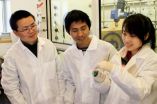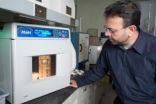(Press-News.org) BETHLEHEM, PA—A team of electrical engineers and chemists at Lehigh University have experimentally verified the "rainbow" trapping effect, demonstrating that plasmonic structures can slow down light waves over a broad range of wavelengths.
The idea that a rainbow of broadband light could be slowed down or stopped using plasmonic structures has only recently been predicted in theoretical studies of metamaterials. The Lehigh experiment employed focused ion beams to mill a series of increasingly deeper, nanosized grooves into a thin sheet of silver. By focusing light along this plasmonic structure, this series of grooves or nano-gratings slowed each wavelength of optical light, essentially capturing each individual color of the visible spectrum at different points along the grating. The findings hold promise for improved data storage, optical data processing, solar cells, bio sensors and other technologies.
While the notion of slowing light or trapping a rainbow sounds like ad speak, finding practical ways to control photons—the particles that makes up light— could significantly improve the capacity of data storage systems and speed the processing of optical data.
The research required the ability to engineer a metallic surface to produce nanoscale periodic gratings with varying groove depths. This alters the optical properties of the nanopatterned metallic surface, called Surface Dispersion Engineering. The broadband surface light waves are then trapped along this plasmonic metallic surface with each wavelength trapped at a different groove depth, resulting in a trapped rainbow of light.
Through direct optical measurements, the team showed that light of different wavelengths in the 500-700nm region was "trapped" at different positions along the grating, consistent with computer simulations. To prepare the nanopattern gratings required "milling" 150nm wide rectangular grooves every 520nm along the surface of a 300-nm-thick silver sheet. While intrinsic metal loss on the surface of the metal did not permit the complete "stopping" of these plasmons, future research may look into compensating this loss in an effort to stop light altogether.
"Metamaterials, which are man-made materials with feature sizes smaller than the wavelength of light, offer novel applications in nanophotonics, photovoltaic devices, and biosensors on a chip," said Filbert J. Bartoli, principal investigator, professor and chair of the Department of Electrical and Computer Engineering. "Creating such nanoscale patterns on a metal film allows us to control and manipulate light propogation. The findings of this paper present an unambiguous experimental demonstration of rainbow trapping in plasmonic nanostructures, and represents an important step in this direction."
"This technology for slowing light at room temperature can be integrated with other materials and components, which could lead to novel platforms for optical circuits. The ability of surface plasmons to concentrate light within nanoscale dimensions makes them very promising for the development of biosensors on chip and the study of nonlinear optical interactions," said Qiaoqiang Gan, who completed this work while a doctoral candidate at Lehigh University, and is now an assistant professor in the Department of Electrical Engineering , State University of New York at Buffalo.
INFORMATION:
The study was conducted by Bartoli, Qiaoqiang Gan, Yongkang Gao and Yujie J. Ding of the Center for Optical Technologies in the Department of Electrical and Computer Engineering at Lehigh University; and Kyle Wagner and Dmitri V. Vezenov of the Department of Chemistry at Lehigh.
The study was funded by the National Science Foundation. It is published in the current issue of the Proceedings of the National Academy of Sciences.
Trapping a rainbow: Lehigh researchers slow broadband light waves with nanoplasmonic structures
2011-03-15
ELSE PRESS RELEASES FROM THIS DATE:
Research shows rapid adoption of newer, more expensive prostate cancer treatments
2011-03-15
Boston, MA – With 180,000 men diagnosed with prostate cancer each year, it is one of the most common types of cancer in the country. For this reason, it has been cited as a good marker for health care spending in general, reflective of the greater trends across the United States. New research from the Dana-Farber/Brigham and Women's Cancer Center (DF/BWCC) shows that newer, more expensive treatment options for prostate cancer were adopted rapidly and widely during 2002 – 2005 without proof of their cost-effectiveness, and may offer explanations for why health care spending ...
Key mutations act cooperatively to fuel aggressive brain tumor
2011-03-15
Mutations in three pathways important for suppressing tumors cooperate to launch glioblastoma, an aggressive brain tumor that strikes children and adults. But new research from St. Jude Children's Research Hospital scientists shows those changes alone are not sufficient to cause cancer. Tumor formation requires additional mutations, some affecting different points in the same disrupted regulatory pathways.
Researchers demonstrated that in mouse models of glioblastoma, tumors develop in several regions of the brain.
The findings, as well as the technique investigators ...
Why argue? Helping students see the point
2011-03-15
Read the comments on any website and you may despair at Americans' inability to argue well. Thankfully, educators now name argumentive reasoning as one of the basics students should leave school with.
But what are these skills and how do children acquire them? Deanna Kuhn and Amanda Crowell, of Columbia University's Teachers College, have designed an innovative curriculum to foster their development and measured the results. Among their findings, published in Psychological Science, a journal of the Association for Psychological Science, dialogue is a better path to developing ...
Study puts notch on the jagged edge of lung cancer metastasis
2011-03-15
HOUSTON - Researchers discovered a new, key component in the spread of lung cancer as well as a likely way to block it with drugs now in clinical trial. The study was published today (Monday, March 14) in the Journal of Clinical Investigation.
A team led by scientists at The University of Texas MD Anderson Cancer Center found a way to identify metastasis-prone lung cancer cells and then uncovered a mechanism that shifts primary tumor cells into a more deadly type of cell with the capacity to move elsewhere in the body.
"We think tumors have to learn how to metastasize ...
DU researchers find that headway being made fighting communicable diseases globally
2011-03-15
DENVER – Those working for healthier humans around the globe are making headway in fighting communicable diseases such as AIDS, malaria and diarrheal illness, according to research from the Frederick S. Pardee Center for International Futures in the University of Denver's (DU) Josef Korbel School of International Studies.
The center recently released the third in a series of five volumes that focus on human progress in which researchers explore topics such as education, poverty, infrastructure and governance. The latest book is Improving Global Health: Forecasting the ...
Nanorods developed in UC Riverside lab could greatly improve visual display of information
2011-03-15
VIDEO:
When an external magnetic field is applied to the solution of nanorods, they align themselves parallel to one another like a set of tiny flashlights turned in one direction, and...
Click here for more information.
RIVERSIDE, Calif. – Chemists at the University of California, Riverside have developed tiny, nanoscale-size rods of iron oxide particles in the lab that respond to an external magnetic field in a way that could dramatically improve how visual information ...
NJIT prof offers new desalination process using carbon nanotubes
2011-03-15
A faster, better and cheaper desalination process enhanced by carbon nanotubes has been developed by NJIT Professor Somenath Mitra. The process creates a unique new architecture for the membrane distillation process by immobilizing carbon nanotubes in the membrane pores. Conventional approaches to desalination are thermal distillation and reverse osmosis.
"Unfortunately the current membrane distillation method is too expensive for use in countries and municipalities that need potable water," said Mitra. "Generally only industry, where waste heat is freely available, ...
Guided care reduces the use of health services by chronically ill older adults
2011-03-15
A new report shows that older people who receive Guided Care, a new form of primary care, use fewer expensive health services compared to older people who receive regular primary care. Research published in the March 2011 edition of Archives of Internal Medicine found that after 20 months of a randomized controlled trial, Guided Care patients experienced, on average, 30 percent fewer home health care episodes, 21 percent fewer hospital readmissions, 16 percent fewer skilled nursing facility days, and 8 percent fewer skilled nursing facility admissions. Only the reduction ...
Antioxidants in pregnancy prevent obesity in animal offspring
2011-03-15
New biological research may be relevant to the effects of a mother's high-fat diet during pregnancy on the development of obesity in her children.
An animal study at The Children's Hospital of Philadelphia suggests that a high-fat, high-carbohydrate diet causes oxidative stress -- an excess of deleterious free radicals -- during pregnancy, predisposing the offspring to obesity and diabetes. Feeding rats antioxidants before and during pregnancy completely prevented obesity and glucose intolerance in their offspring.
If the results in animals prove to be similar ...
Surgical technique helps adult male survivors of childhood cancer regain fertility
2011-03-15
A new study has shown that a surgical technique called microdissection testicular sperm extraction (TESE) can effectively locate and extract viable sperm in more than one-third of adult male childhood cancer survivors who were previously considered sterile due to prior chemotherapy treatment. As a result, many of the men were subsequently able to father children with the help of in vitro fertilization. The findings offer a new option for many cancer survivors who want to have children but were thought infertile because of earlier cancer treatment.
"It was previously ...



